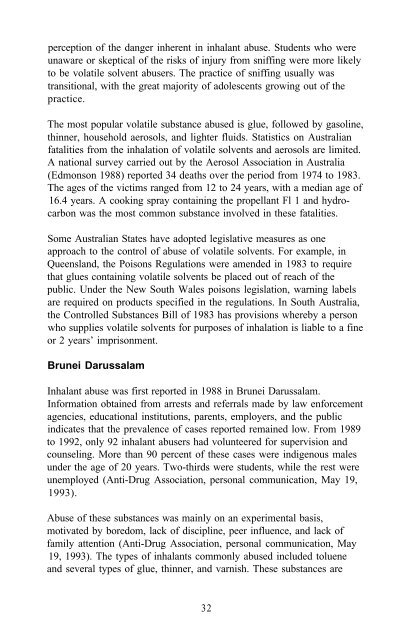Epidemiology of Inhalant Abuse - Archives - National Institute on ...
Epidemiology of Inhalant Abuse - Archives - National Institute on ...
Epidemiology of Inhalant Abuse - Archives - National Institute on ...
You also want an ePaper? Increase the reach of your titles
YUMPU automatically turns print PDFs into web optimized ePapers that Google loves.
percepti<strong>on</strong> <str<strong>on</strong>g>of</str<strong>on</strong>g> the danger inherent in inhalant abuse. Students who were<br />
unaware or skeptical <str<strong>on</strong>g>of</str<strong>on</strong>g> the risks <str<strong>on</strong>g>of</str<strong>on</strong>g> injury from sniffing were more likely<br />
to be volatile solvent abusers. The practice <str<strong>on</strong>g>of</str<strong>on</strong>g> sniffing usually was<br />
transiti<strong>on</strong>al, with the great majority <str<strong>on</strong>g>of</str<strong>on</strong>g> adolescents growing out <str<strong>on</strong>g>of</str<strong>on</strong>g> the<br />
practice.<br />
The most popular volatile substance abused is glue, followed by gasoline,<br />
thinner, household aerosols, and lighter fluids. Statistics <strong>on</strong> Australian<br />
fatalities from the inhalati<strong>on</strong> <str<strong>on</strong>g>of</str<strong>on</strong>g> volatile solvents and aerosols are limited.<br />
A nati<strong>on</strong>al survey carried out by the Aerosol Associati<strong>on</strong> in Australia<br />
(Edm<strong>on</strong>s<strong>on</strong> 1988) reported 34 deaths over the period from 1974 to 1983.<br />
The ages <str<strong>on</strong>g>of</str<strong>on</strong>g> the victims ranged from 12 to 24 years, with a median age <str<strong>on</strong>g>of</str<strong>on</strong>g><br />
16.4 years. A cooking spray c<strong>on</strong>taining the propellant Fl 1 and hydrocarb<strong>on</strong><br />
was the most comm<strong>on</strong> substance involved in these fatalities.<br />
Some Australian States have adopted legislative measures as <strong>on</strong>e<br />
approach to the c<strong>on</strong>trol <str<strong>on</strong>g>of</str<strong>on</strong>g> abuse <str<strong>on</strong>g>of</str<strong>on</strong>g> volatile solvents. For example, in<br />
Queensland, the Pois<strong>on</strong>s Regulati<strong>on</strong>s were amended in 1983 to require<br />
that glues c<strong>on</strong>taining volatile solvents be placed out <str<strong>on</strong>g>of</str<strong>on</strong>g> reach <str<strong>on</strong>g>of</str<strong>on</strong>g> the<br />
public. Under the New South Wales pois<strong>on</strong>s legislati<strong>on</strong>, warning labels<br />
are required <strong>on</strong> products specified in the regulati<strong>on</strong>s. In South Australia,<br />
the C<strong>on</strong>trolled Substances Bill <str<strong>on</strong>g>of</str<strong>on</strong>g> 1983 has provisi<strong>on</strong>s whereby a pers<strong>on</strong><br />
who supplies volatile solvents for purposes <str<strong>on</strong>g>of</str<strong>on</strong>g> inhalati<strong>on</strong> is liable to a fine<br />
or 2 years’ impris<strong>on</strong>ment.<br />
Brunei Darussalam<br />
<str<strong>on</strong>g>Inhalant</str<strong>on</strong>g> abuse was first reported in 1988 in Brunei Darussalam.<br />
Informati<strong>on</strong> obtained from arrests and referrals made by law enforcement<br />
agencies, educati<strong>on</strong>al instituti<strong>on</strong>s, parents, employers, and the public<br />
indicates that the prevalence <str<strong>on</strong>g>of</str<strong>on</strong>g> cases reported remained low. From 1989<br />
to 1992, <strong>on</strong>ly 92 inhalant abusers had volunteered for supervisi<strong>on</strong> and<br />
counseling. More than 90 percent <str<strong>on</strong>g>of</str<strong>on</strong>g> these cases were indigenous males<br />
under the age <str<strong>on</strong>g>of</str<strong>on</strong>g> 20 years. Two-thirds were students, while the rest were<br />
unemployed (Anti-Drug Associati<strong>on</strong>, pers<strong>on</strong>al communicati<strong>on</strong>, May 19,<br />
1993).<br />
<str<strong>on</strong>g>Abuse</str<strong>on</strong>g> <str<strong>on</strong>g>of</str<strong>on</strong>g> these substances was mainly <strong>on</strong> an experimental basis,<br />
motivated by boredom, lack <str<strong>on</strong>g>of</str<strong>on</strong>g> discipline, peer influence, and lack <str<strong>on</strong>g>of</str<strong>on</strong>g><br />
family attenti<strong>on</strong> (Anti-Drug Associati<strong>on</strong>, pers<strong>on</strong>al communicati<strong>on</strong>, May<br />
19, 1993). The types <str<strong>on</strong>g>of</str<strong>on</strong>g> inhalants comm<strong>on</strong>ly abused included toluene<br />
and several types <str<strong>on</strong>g>of</str<strong>on</strong>g> glue, thinner, and varnish. These substances are<br />
32
















